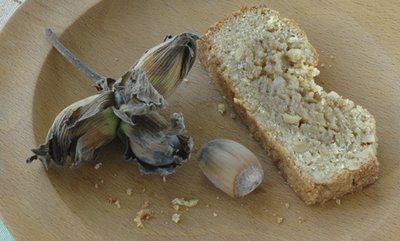
When poorly advised persons think of British baking, it may well be that monstrously hard rock cakes, rejected by even the dog, are what such folk think of. The epitome of a lack of basic skill and care in the baking department. Rock cakes, admittedly, do have a bad reputation, and their title does make for easy mocking. However, the name is supposed to be for their appearance, NOT their solidity. I think that rock cakes also suffer from being seen as old-fashioned. One can imagine them on the station tearoom counter, under a glass dome, in the film 'Brief Encounter'. But think, this should lend them an air of illicit pleasure, should it not? When I mentioned to friends that I was planning to bake rock cakes, the common response was, "I remember making those at school." Good old domestic science - teaching us the skills for modern life. So why did we not grow up to bake rock cakes on a regular basis? Did we become sidetracked by chocolate brownies, American muffins and cookies? Or was it simply that rock cakes are, whatever the skill of the baker, a second rate cake?
Rock cakes were a ubiquitous feature of school fetes, church teas, railway refreshments etc. They don't have a specific geographic origination, and the OUP 'A-Z of Food' credits Mrs Beeton with the earliest documented recipe for them. Mrs Beeton's orignal 'Household Management' was published in 1861 Her recipe (no. 1747) is for 'Rock Biscuits' rather than cakes. I don't have a copy of 'Household Management' (seem to manage OK under my own rules, thanks), so I used the recipe from this website.
Now, at first glance I was a little horrified at the proportions of sugar to flour, and the large number of eggs involved. I decided to half the recipe. A wise decision it turned out. I had a lovely time whisking the eggs to form a good thick froth, and then adding the sugar gradually, and then the flour. It was at this point I could see an obvious flaw to the recipe - what I had in my bowl was a batter not a dough. It looked far too runny to be able to form into 'rocky' looking biscuits. I added some more flour, but then thought that if I am trying a recipe from the original context, then I should follow it to see how it turns out. So I added a couple of handfuls of currants, and then spooned some mixture onto a baking sheet. Mrs Beeton's instructions state that you should use a fork to make the mixture (she calls it a dough) look as rough as possible. Sorry Isabella, but this just was not possible. Baking sheet number one went into the oven, and I tipped more flour into my bowl (lost track of quantities by this point), and I mixed in enough to bring the mixture together into a more dough-like consistency. By this point I was concerned that I was undoing all my good whisking work, and I decided to spoon out the mixture, roughen surface with a fork, and stick baking sheet number two into the oven.
Neither sets of biscuits looked quite how I imagined that they would.
 Baking sheet no. 1
Baking sheet no. 1
Baking sheet no. 2
Unfortunately, nor were they good to eat. Dry, hard and despite all the sugar and eggs, very bland. Sorry Mrs B., but these biscuits did not rock.
So I turned to a cookbook published in 1948, just three years after 'Brief Encounter' was first screened. I felt confident that by this date, rock cakes had evolved into a more edible proposition.
Orange Rock Cakes (from Elizabeth Craig's 'Economical Cookery')
225g flour
2 teaspoons baking powder
1 egg - beaten well
75g fine sugar
75g butter or margarine
Grated rind and juice of 1 orange
25g candied peel - finely chopped
1. Preheat oven to 180C/350F/Gas 4.
2. Prepare baking sheets.
3. Sift the flour and baking powder into a basin.
4. Rub in the fat.
5. Stir in the sugar, orange rind and juice, candied peel, and beaten egg.
6. Mix to a very stiff dough, then with two forks take pieces the size of a walnut and place a little apart on the baking sheets.
7. Bake for 10-15 minutes until golden.

Success! Not only did the consistency of the dough prior to baking look right, but the finished cakes were golden and had a good cragginess to them. Each cake made a brief encounter with my plate before disappearing. Texturewise they were pretty similar to a scone, and the hint of orange was a nice touch. They were good the day of baking, but not bad a day later. Cakes/buns of this type can always be revived by the spreading of a decent bit of butter. Time for a rock cake renaissance I think.



